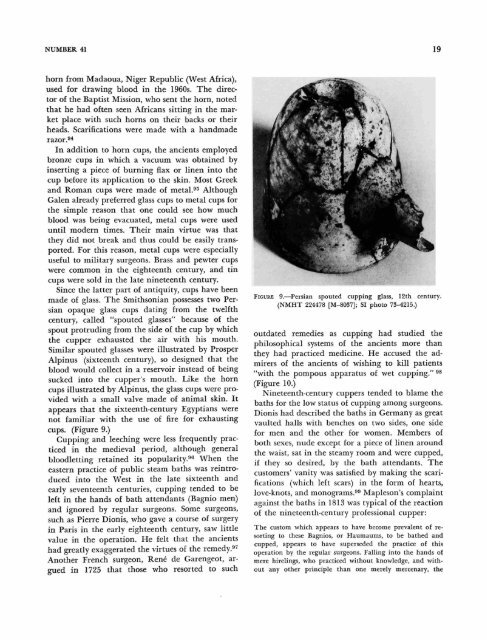BLOODLETTING INSTRUMENTS - Smithsonian Institution Libraries
BLOODLETTING INSTRUMENTS - Smithsonian Institution Libraries
BLOODLETTING INSTRUMENTS - Smithsonian Institution Libraries
Create successful ePaper yourself
Turn your PDF publications into a flip-book with our unique Google optimized e-Paper software.
NUMBER 41 19<br />
horn from Madaoua, Niger Republic (West Africa),<br />
used for drawing blood in the 1960s. The director<br />
of the Baptist Mission, who sent the horn, noted<br />
that he had often seen Africans sitting in the market<br />
place with such horns on their backs or their<br />
heads. Scarifications were made with a handmade<br />
razor.^*<br />
In addition to horn cups, the ancients employed<br />
bronze cups in which a vacuum was obtained by<br />
inserting a piece of burning flax or linen into the<br />
cup before its application to the skin. Most Greek<br />
and Roman cups were made of metal.^^ Although<br />
Galen already preferred glass cups to metal cups for<br />
the simple reason that one could see how much<br />
blood was being evacuated, metal cups were used<br />
until modern times. Their main virtue was that<br />
they did not break and thus could be easily transported.<br />
For this reason, metal cups were especially<br />
useful to military surgeons. Brass and pewter cups<br />
were common in the eighteenth century, and tin<br />
cups were sold in the late nineteenth century.<br />
Since the latter part of antiquity, cups have been<br />
made of glass. The <strong>Smithsonian</strong> possesses two Persian<br />
opaque glass cups dating from the twelfth<br />
century, called "spouted glasses" because of the<br />
spout protruding from the side of the cup by which<br />
the cupper exhausted the air with his mouth.<br />
Similar spouted glasses were illustrated by Prosper<br />
Alpinus (sixteenth century), so designed that the<br />
blood would collect in a reservoir instead of being<br />
sucked into the cupper's mouth. Like the horn<br />
cups illustrated by Alpinus, the glass cups were provided<br />
with a small valve made of animal skin. It<br />
appears that the sixteenth-century Egyptians were<br />
not familiar with the use of fire for exhausting<br />
cups. (Figure 9.)<br />
Cupping and leeching were less frequently practiced<br />
in the medieval period, although general<br />
bloodletting retained its popularity.^^ When the<br />
eastern practice of public steam baths was reintroduced<br />
into the West in the late sixteenth and<br />
early seventeenth centuries, cupping tended to be<br />
left in the hands of bath attendants (Bagnio men)<br />
and ignored by regular surgeons. Some surgeons,<br />
such as Pierre Dionis, who gave a course of surgery<br />
in Paris in the early eighteenth century, saw little<br />
value in the operation. He felt that the ancients<br />
had greatly exaggerated the virtues of the remedy.^'^<br />
Another French surgeon, Ren^ de Garengeot, argued<br />
in 1725 that those who resorted to such<br />
FIGURE 9.—Persian spouted cupping glass, 12 th century.<br />
(NMHT 224478 [M-8037]; SI photo 73-4215.)<br />
outdated remedies as cupping had studied the<br />
philosophical systems of the ancients more than<br />
they had practiced medicine. He accused the admirers<br />
of the ancients of wishing to kill patients<br />
"with the pompous apparatus of wet cupping." ^^<br />
(Figure 10.)<br />
Nineteenth-century cuppers tended to blame the<br />
baths for the low status of cupping among surgeons.<br />
Dionis had described the baths in Germany as great<br />
vaulted halls with benches on two sides, one side<br />
for men and the other for women. Members of<br />
both sexes, nude except for a piece of linen around<br />
the waist, sat in the steamy room and were cupped,<br />
if they so desired, by the bath attendants. The<br />
customers' vanity was satisfied by making the scarifications<br />
(which left scars) in the form of hearts,<br />
love-knots, and monograms.^^ Mapleson's complaint<br />
against the baths in 1813 was typical of the reaction<br />
of the nineteenth-century professional cupper:<br />
The custom which appears to have become prevalent of resorting<br />
to these Bagnios, or Haumaums, to be bathed and<br />
cupped, appears to have superseded the practice of this<br />
operation by the regular surgeons. Falling into the hands of<br />
mere hirelings, who practiced without knowledge, and without<br />
any other principle than one merely mercenary, the
















